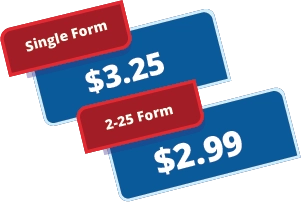E-file IRS 1099-C Form Online with Tax2efile
Say goodbye to manual filing hassles. Simplify your 1099-C Form with Tax2efile for a seamless and accurate submission. If you are a financial institution or other business that canceled the debt of $600 or more, you are obligated to file your return with the IRS. Get started with Tax2efile today and we guarantee you a smooth tax e-filing experience.

What is Form 1099-C?
Form 1099-C (cancellation of debt) is the information return used for the reporting of cancelled debt. A lender may report Form 1099-C to IRS when a debt becomes unenforceable due to an event or cancelation of the debt owed.
Common types are:
- Repossession
- The return of property to a lender
- Abandonment of property
- Foreclosure
- The modification of a mortgage on your principal residence
- Resolving a credit card debt
The user does not have to file a 1099-C tax return when there has been a fraudulent debt and has been cancelled due to identity theft. The cancelled income is used as other income on Form 1040 (or Form 1040-SR ). The Issuer will send the taxpayers a Form 1099-C by January 31st.
Guide to File Form 1099-C
- The form includes details on creditors and borrowers.
- For the debtor, the form will ask for the names, addresses, Tax Identification Numbers (TIN), and the associated account number.
- The amounts reported on this form may include principal, interest, fines, late fees, penalties, and administrative costs.
- The filer will receive this tax return by January 31st of the year after the debt has been cancelled or forgiven.


Watch our step-by-step video on How to E-File IRS Form 1099-C with Tax2efile
Who Must File 1099-C Form?
The lender files a 1099-C with IRS and the IRS sends the filer a copy of the Form 1099-C. You may file Form 1099-C if the user is:
- A financial institution (such as a domestic bank, trust company, building and loan association, or savings and loan association).
- A credit union.
- A corporation that is a subsidiary of a financial institution or credit union.
- A federal government agency.
- Any organization whose significant trade or business is the lending of money.
To obtain more information on the Form 1099-C, click here
The filer may be able to exclude the cancellation of debt income if one of the below conditions applies:
- The debt was discharged in bankruptcy.
- The debt was qualified as main home/farm indebtedness (applies through 2025).
- The filer was insolvent.
- The debt was qualified real property business indebtedness.
When is the Form 1099-C Deadline?
| Filing Type | Deadline |
|---|---|
| Recipient copy | January 31st |
| IRS Paper Filing | February 28th |
| IRS Electronic Filing | March 31st |
Note: If the due date/deadline falls on a Saturday, Sunday, or federal holiday, the filer will need to E-file on the next business day.
Get Started by Registering with Tax2efile Today!
Our IRS-approved e-fling services make tax season stress-free. Sign up Today!

Frequently Ask Questions
Find answers to commonly asked questions about our products and services.
Form 1099-C is used for cancellations of debts for which the debtor actually incurred the underlying debt.
If you are a financial institution, such as a domestic bank, a trust company, a credit union, executive agency, a military department subsidiary relationship.
Details of Creditor Information & Tin of Creditor, Debtor Information, Tin as well as the amounts that have been cumulated.
Yes, Tax2efile offers a bulk upload feature that allows the user to upload all of the payers to an excel sheet for a faster process.
Tax2efile allows you to correct a mistake to the recipient’s information for TINs, Names & amounts.
Generally, student loan forgiveness is not reported on Form 1099-C. However, certain circumstances may trigger taxable income, and it’s advisable to consult with a tax advisor to determine if filing Form 1099-C is necessary.
Generally, if an individual forgives a personal loan, it may not trigger a Form 1099-C. However, it’s important to understand the tax implications, and consulting with a tax professional is recommended.
Failure to file Form 1099-C when required may result in penalties. It’s essential to adhere to the IRS deadlines and fulfil reporting obligations to avoid any financial consequences.
Yes, Tax2efile offers printing and mailing service! Our dedicated team will print and mail out each form you filed.
Using our fast electronic service, you can complete your filing within 5 minutes.
To file Form 1099-C for a single return the filing fee is $3.25.
The IRS requires Form 1099-C to be submitted by February 28 through the mail and by March 31 if you file the form electronically however, recipients’ copy should be mailed by January 31.
Failure to file the 1099 form by the deadline may result in IRS penalties. The penalty can be from $60 per 1099 Form, the maximum penalty can be up to $630,500. If you submit Form more than 31 days to before August 1, the penalty increases to $120 per 1099 Form and maximum penalty up to $1,891,500. If you file after August 1, the penalty can be from $310 per 1099 Form and maximum penalty up to $3,783,000. Additionally, there are penalties for failure to furnish the payee statement.
Yes, if you had credit card debt cancelled, it may trigger the need to file Form 1099-C. Report accurate details related to the cancellation of credit card debt to comply with IRS regulations.
Medical debt forgiveness may trigger the need to file Form 1099-C. Report accurate details regarding the cancelled medical debt on the form for proper IRS compliance.
Still have questions?
If you have more questions, please refer to our FAQ page. Contact our customer support team for assistance.





